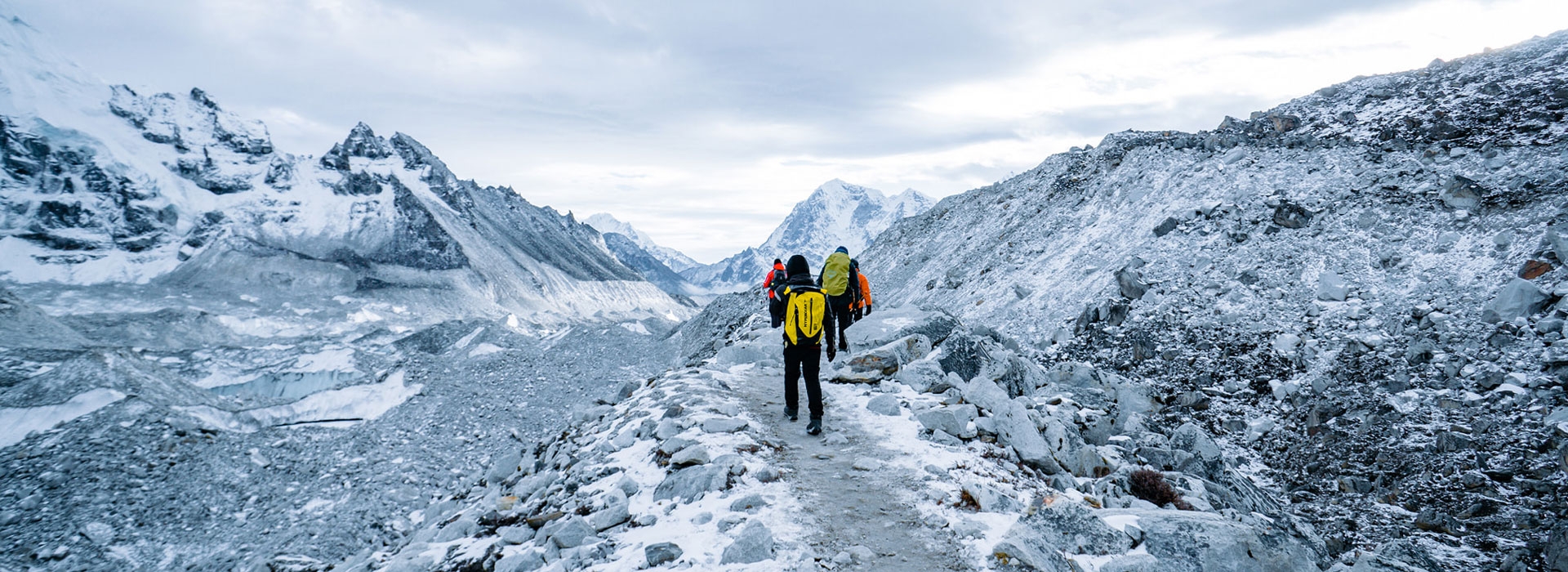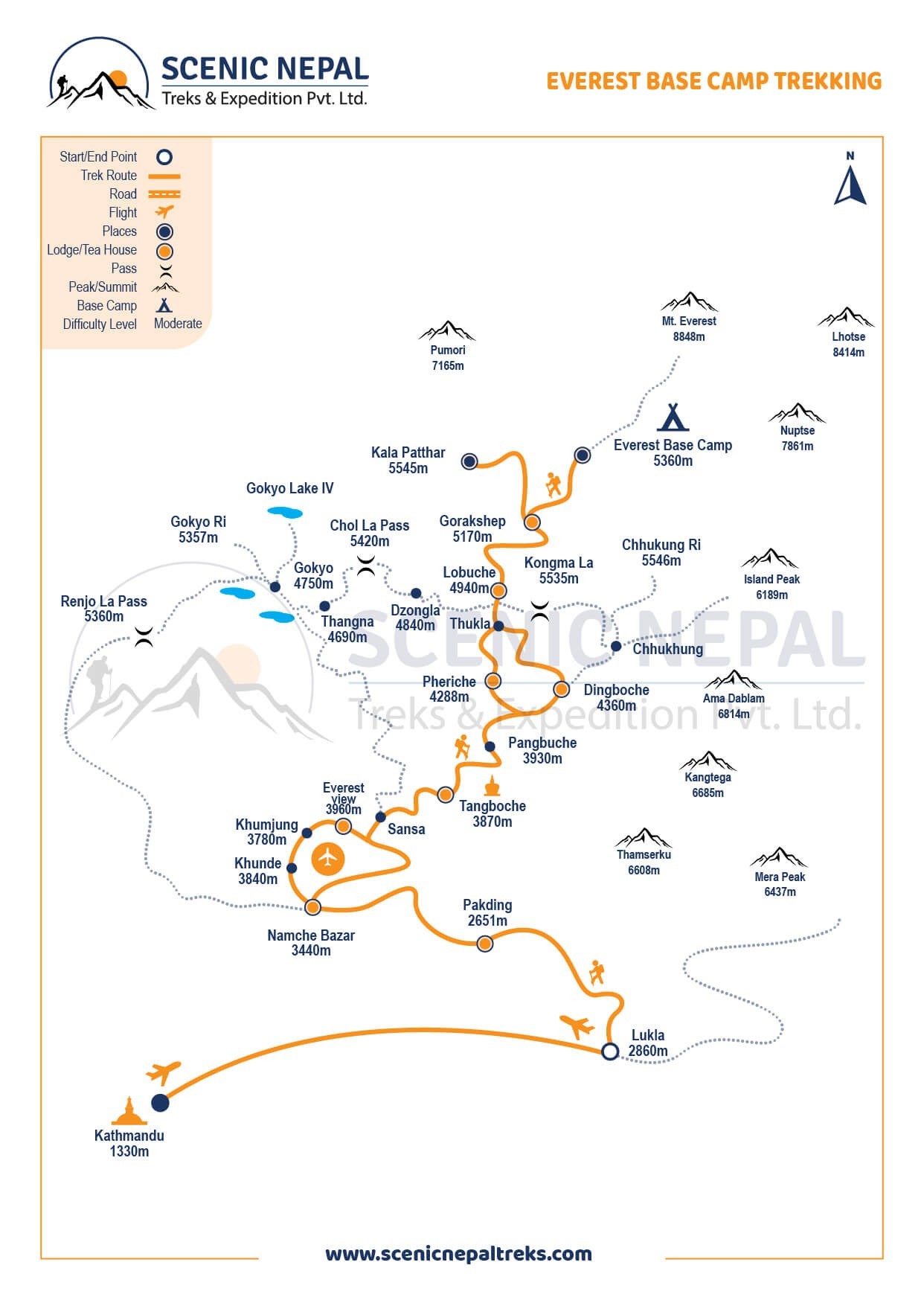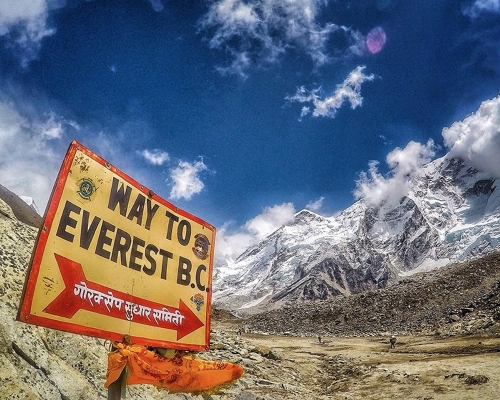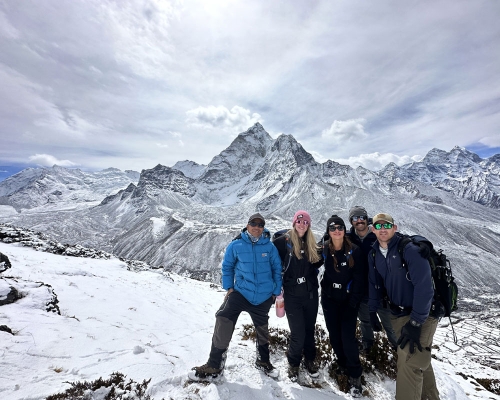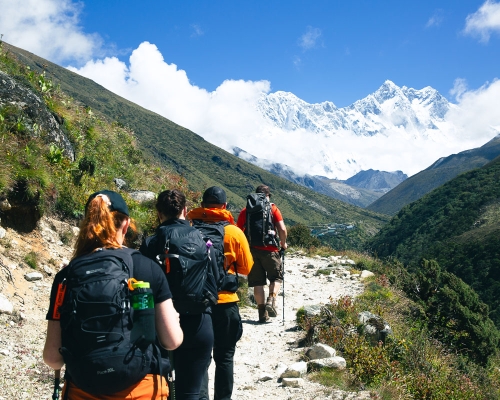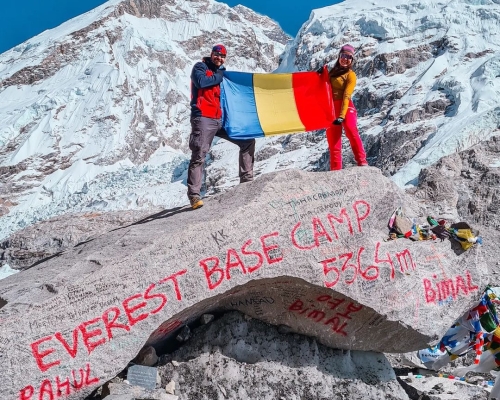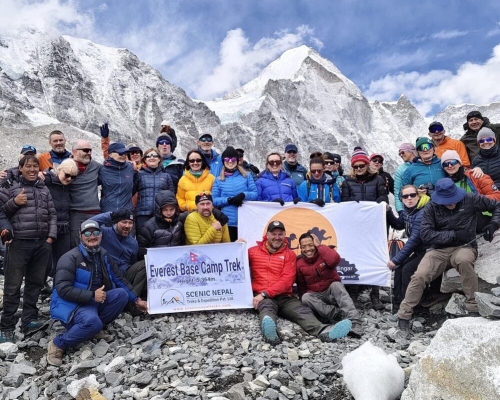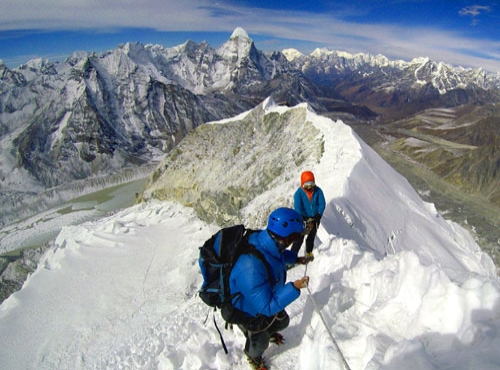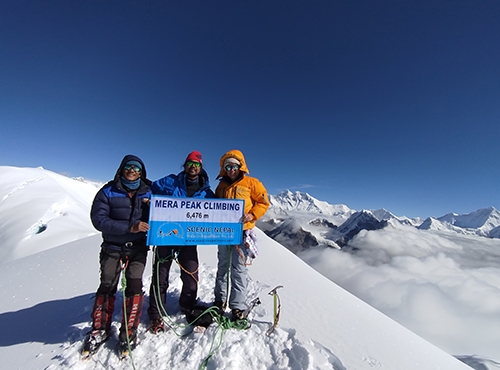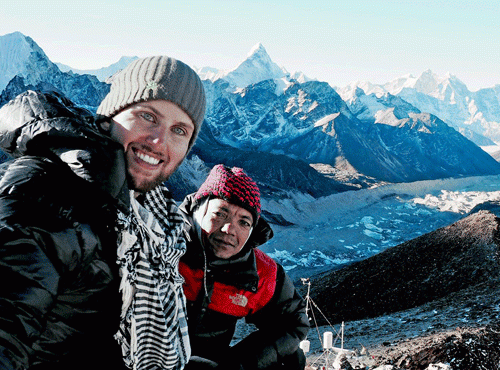Who Is This Trek For?
The 15-day Everest Base Camp trek is designed for adventurers who are physically fit and looking for a moderately challenging trekking experience. No technical climbing skills are required, but trekkers should be prepared for high altitudes and long days of hiking. Acclimatization days are built into the itinerary to help your body adjust to the altitude, reducing the risk of altitude sickness.
Best time to do Everest Base Camp Trek :-
The best time to do the Everest Base Camp Trek is during the pre-monsoon season from March to May and post-monsoon season from late September to November.
During these months, the weather in the Everest region is relatively dry and stable, with clear skies and mild temperatures. This makes it an ideal time for trekking, as the views of the stunning Himalayan mountains, including Mount Everest, are at their best.
During the pre-monsoon season, the vegetation and wildflowers are in full bloom, and the weather is warm and sunny. The post-monsoon season is also an excellent time to trek, as the monsoon rains have cleared the air of dust and pollution, resulting in stunningly clear views of the mountains.
It is important to note that the weather in the Everest region can be unpredictable and change rapidly, so it is essential to pack appropriate clothing and gear for all conditions. It is also advisable to be prepared for altitude sickness and to acclimatize properly before attempting to trek to higher altitudes.
Overall, the best time to do the Everest Base Camp Trek is during the pre-monsoon and post-monsoon seasons, but it is essential to check the weather forecast before embarking on the trek and to be prepared for all conditions.
Accommodation on Everest Base Camp trek :-
Accommodation options on the Everest Base Camp Trek vary depending on the location and altitude of each stop along the trail.
Lower altitudes (below 3,500 meters) typically offer guesthouses, tea houses, and lodges with basic amenities such as shared bathrooms, hot showers, and simple meals. These accommodations are usually operated by local Sherpa families and provide a comfortable and authentic experience.
At higher altitudes (above 3,500 meters), the accommodation options become more basic, and the facilities are more limited. These include small lodges with basic dormitory-style rooms or individual rooms with shared bathrooms. The availability of hot showers may be limited, and the meals may be more basic due to the remoteness of the location.
It is important to note that accommodation options on the Everest Base Camp Trek can be limited and book up quickly, especially during peak season (March to May and September to November). Therefore, it is advisable to make reservations in advance or to have a trusted guide who can arrange accommodation along the way.
Many travelers prefer to bring their own sleeping bags and personal camping gear for added comfort and convenience. It is important to contact us before bringing any gear to ensure that it is suitable for the trek.
Overall, the accommodation on the Everest Base Camp Trek is basic but comfortable, and the hospitality and warmth of the local Sherpa families make for a truly memorable experience.
Food during the trek :-
Meals on the Everest Base Camp Trek are generally provided by the teahouses and lodges along the trekking route. The meals are usually simple, nutritious, and filling, and are designed to provide trekkers with the energy and sustenance they need for the demanding trek.
The most common meal on the trek is dal bhat, a traditional Nepali dish consisting of rice, lentil soup, and a variety of cooked vegetables. Dal bhat is usually served with a side of pickles and papadums and is a good source of carbohydrates and protein.
Other popular meals on the trek include noodles, pasta, and soups, which are often served with vegetables, eggs, or meat. Tea, coffee, and hot chocolate are also available at most teahouses and lodges, as well as a limited selection of snacks and beverages.
It is important to note that the food and water on the trek are usually cooked and prepared by the teahouses and lodges. Trekkers should ensure that they only consume boiled or treated water and avoid uncooked or raw foods to prevent the risk of waterborne illnesses.
For trekkers with dietary restrictions or preferences, some teahouses and lodges offer vegetarian, vegan, and gluten-free options. It is advisable to inform the teahouse or lodge in advance of any dietary requirements to ensure that suitable meals are provided.
Overall, the meals on the Everest Base Camp Trek are basic but nutritious, providing trekkers with the energy they need for the demanding trek. Trekkers can also enjoy the local cuisine and experience the culture and traditions of the Everest region through the food they eat.
Trekking Insurance :-
Having travel insurance for the Everest Base Camp Trek is highly recommended. The insurance should cover medical emergencies, trip cancellations, and evacuations in case of emergencies or accidents on the trek.
Medical emergencies can be costly, especially at higher altitudes, and having insurance can provide peace of mind and financial protection. The insurance should cover medical expenses, including emergency evacuation by helicopter if necessary. It is important to check the details of the insurance policy carefully to ensure that it covers the altitude and activities involved in the trek.
In addition to medical emergencies, the insurance should also cover trip cancellations or interruptions due to unforeseen circumstances, such as flight cancellations or delays, illness, or natural disasters. This can provide financial protection for any expenses incurred due to the cancellation or interruption of the trek.
It is advisable to purchase travel insurance from a reputable provider and to check the policy details carefully to ensure that it provides adequate coverage for the Everest Base Camp Trek. The insurance should also be purchased well in advance of the trek to ensure that coverage is in place before departure.
Overall, having travel insurance for the Everest Base Camp Trek is essential to ensure that trekkers are protected financially and have access to medical assistance in case of emergencies or accidents on the trek.
Everest Base Camp Trek and Challenges :-
The Everest Base Camp Trek is considered one of the most challenging treks in the world due to its high altitude, steep terrain, and unpredictable weather conditions. Here are some of the challenges that trekkers may encounter during the trek:
- Altitude sickness: As trekkers ascend to higher altitudes, the air becomes thinner and the oxygen levels decrease. This can cause altitude sickness, which can range from mild symptoms like headaches and nausea to more severe conditions like high altitude pulmonary edema (HAPE) and high altitude cerebral edema (HACE). Trekkers need to properly acclimatize by taking rest days and drinking plenty of fluids to prevent altitude sickness.
- Extreme weather conditions: The weather in the Himalayas can be unpredictable, with sudden changes in temperature and frequent snow and rain. Trekkers may encounter blizzards, high winds, and heavy snowfall, which can make the trek more challenging and dangerous. Trekkers need to be prepared for all types of weather conditions and carry appropriate clothing and gear.
- Physical demands: The Everest Base Camp Trek involves long hours of walking over steep terrain, which can be physically demanding. Trekkers need to be in good physical shape and have sufficient stamina to complete the trek. Training before the trek and carrying a light backpack can help to minimize physical strain.
- Basic facilities: The teahouses along the trek route provide basic accommodation and meals, but the facilities can be limited and sometimes unreliable. Trekkers may encounter issues with cleanliness, availability of hot water, and electricity. It's important to carry necessary items like toilet paper, hand sanitizer, and a headlamp.
- Remote location: The Everest Base Camp Trek takes place in a remote area of the Himalayas, with limited access to medical facilities and emergency services. Trekkers need to be prepared for emergencies and carry a comprehensive medical kit, including medications for altitude sickness.
Despite the challenges, the Everest Base Camp Trek is a rewarding and unforgettable experience for those who are up for the adventure. Proper preparation, acclimatization, and a positive attitude can help trekkers overcome the challenges and complete the trek successfully.
How to Train for the Everest Base Camp Trek :-
The Everest Base Camp trek is a challenging yet incredibly rewarding adventure that requires physical and mental preparation. As you embark on this journey to one of the most iconic destinations on earth, your body will face long days of hiking at high altitudes, which makes proper training crucial. Here’s how you can get ready for this once-in-a-lifetime experience:
- Cardiovascular Conditioning: Build Your Endurance To conquer the Everest Base Camp trek, you’ll need a strong cardiovascular foundation. Activities like running, cycling, or swimming are fantastic ways to boost your stamina and improve overall fitness. These exercises will increase your endurance, making those long uphill climbs feel more manageable as you trek towards the base camp.
- Strength Training: Prepare Your Body for the Challenge : Strong muscles will be your best friend on this trek, especially when you’re navigating rocky paths and carrying a backpack for hours. Incorporate strength training into your routine with weightlifting or bodyweight exercises like squats, lunges, and push-ups. Building strength in your legs and core will make the uneven terrain and steep ascents much easier.
- Hiking: Train Like You’ll Trek: The best way to prepare for the Everest Base Camp trek is to mimic the conditions you'll face on the trail. Seek out local hiking trails with varying terrain and gradually increase the distance and elevation of your hikes. This helps your body adapt to the physical strain of hiking at altitude. If you can find steep, rocky paths, even better—this will closely simulate what you’ll encounter on the trail.
- Altitude Training: Get Your Body Ready for Thin Air : Hiking at high altitudes means dealing with lower oxygen levels, so it’s essential to train your body for the reduced air pressure. If possible, try hiking in higher elevations or even using a high-altitude tent or training mask. This will help your body adjust and reduce the chances of altitude sickness once you're on the trek.
- Packing Practice: Get Used to Carrying Gear: The trek involves carrying a backpack filled with your essentials, so it’s a good idea to get used to the weight beforehand. Start with a lighter load and gradually increase the weight as you train. This will prepare your body for the challenge of carrying your gear over long distances and through tough conditions.
- Mental Preparation: Strengthen Your Mind: Physical training is vital, but mental preparation is just as important. The trek can be mentally demanding, and having a positive mindset will help you push through tough moments. Visualize yourself reaching Everest Base Camp, focus on the goal ahead, and practice positive self-talk to stay motivated. Staying mentally strong is key to completing the trek.
- Rest and Recovery: Listen to Your Body : As you ramp up your training, don’t forget to give your body time to rest and recover. Stretch regularly, foam roll after workouts, and ensure you get enough sleep. Recovery is just as important as the training itself, as it allows your muscles to repair and adapt to the intensity of your training.
By gradually building up your endurance, strength, and mental toughness, you’ll be well-prepared for the physical challenges of the Everest Base Camp trek. Remember, the key to success is consistent training, patience, and rest. So start preparing today, and soon you'll be standing at the foot of the world's highest peak, ready for the adventure of a lifetime.
Safety and Acclimatization: Staying Safe on the Everest Base Camp Trek :-
The Everest Base Camp Trek is an exhilarating adventure, but safety should always be your top priority. High altitudes, unpredictable weather, and rugged terrain require careful preparation and awareness. Here’s a detailed guide to staying safe and acclimatizing properly during your trek.
Acclimatize Properly
Altitude sickness is one of the biggest challenges on the Everest Base Camp Trek. Proper acclimatization is essential to avoid serious health risks.
- Follow the Recommended Itinerary: Our 15-day itinerary includes acclimatization days in Namche Bazaar and Dingboche to help your body adjust to the altitude.
- Climb High, Sleep Low: On acclimatization days, hike to a higher elevation during the day and return to a lower altitude to sleep.
- Recognize Symptoms: Be aware of altitude sickness symptoms, such as headaches, nausea, dizziness, and shortness of breath. Inform your guide immediately if you experience any of these.
- Descend if Necessary: If symptoms worsen, descend to a lower altitude as quickly as possible.
Stay Hydrated
Dehydration can worsen altitude sickness and reduce your energy levels.
- Drink Plenty of Water: Aim to drink 3-4 liters of water daily. Carry a reusable water bottle or hydration bladder.
- Avoid Alcohol and Caffeine: These can dehydrate you and increase the risk of altitude sickness.
- Use Water Purification Tablets or Filters: Teahouses provide water, but it’s safer to purify it before drinking.
Travel Insurance
Comprehensive travel insurance is a must for the Everest Base Camp Trek.
- High-Altitude Coverage: Ensure your policy covers trekking up to 6,000 meters.
- Emergency Evacuation: Helicopter evacuation is often the only option in remote areas. Verify that your insurance includes this.
- Medical Expenses: Check that your policy covers treatment for altitude sickness and other medical emergencies.
Hire a Guide
A local guide is invaluable for your safety and overall experience.
- Expert Knowledge: Our guides are trained in first aid, altitude sickness management, and emergency response.
- Navigation: The trail can be challenging to navigate, especially in poor weather. A guide ensures you stay on the right path.
- Cultural Insights: Learn about Sherpa culture, traditions, and the history of the region from your guide.
- Support and Motivation: A guide provides encouragement and assistance, especially during tough sections of the trek.
Additional Safety Tips
- Dress in Layers: The weather can change rapidly. Wear moisture-wicking base layers, insulating mid-layers, and a waterproof outer shell.
- Pace Yourself: Walk slowly and steadily to conserve energy and reduce the risk of altitude sickness.
- Stay on Marked Trails: Avoid shortcuts, as they can be dangerous and increase the risk of accidents.
- Carry a First-Aid Kit: Include bandages, antiseptic cream, painkillers, and altitude sickness medication (Diamox).
- Communicate with Your Guide: Inform your guide if you’re feeling unwell or need assistance.
Why Safety Matters on the Everest Base Camp Trek
The Everest Base Camp Trek is a challenging adventure that takes you through remote and high-altitude terrain. While the rewards are immense, the risks are real. By following these safety and acclimatization tips, you can minimize risks and focus on enjoying the journey.
Lukla Flight & Challenges of Everest Base Camp Trek :-
The flight from Kathmandu to Lukla is a crucial part of the Everest Base Camp Trek, as Lukla is the starting point of the trek. However, this flight is often affected by weather conditions and other factors, which can result in delays and cancellations. Here are some of the challenges that trekkers may encounter with the Lukla flight:
- Weather conditions: The weather in the Himalayas can be unpredictable, with frequent changes in visibility and wind patterns. The Lukla airport is situated in a mountainous region, and its location and topography make it vulnerable to weather-related disruptions. Flights are often delayed or cancelled due to fog, high winds, or other adverse weather conditions.
- Limited infrastructure: The Lukla airport has limited infrastructure and is often congested with a high volume of flights. This can result in delays and cancellations due to issues like runway congestion, lack of parking space, and limited availability of aircraft.
- Safety concerns: The Lukla airport has a reputation for being one of the most dangerous airports in the world due to its short runway, steep incline, and challenging approach. Flight operations are closely monitored for safety, and flights may be cancelled or delayed if the conditions are deemed unsafe.
- Logistics and scheduling: The Lukla flights are scheduled for early morning departures to avoid the worst of the weather conditions, but this also means that trekkers need to arrive in Kathmandu a day or two in advance. This can add to the logistics and scheduling challenges, particularly for those with limited time.
- Cost implications: Delays and cancellations of Lukla flights can result in additional costs, such as extra nights in Kathmandu, missed connecting flights, and changes to travel plans. Trekkers need to be prepared for these potential costs and have a contingency plan in place.
Despite these challenges, the Lukla flight is an essential part of the Everest Base Camp Trek, and trekkers need to be prepared for potential delays and cancellations. It's important to stay informed and communicate regularly with your travel agent or airline to minimize the impact of any disruptions and ensure a smooth and enjoyable trekking experience.
Everest Base Camp Trek difficulty :-
Everest Base Camp Trek is a moderate grade trek that involves 6 to 7 hours of walking every day. A trekker has to be physically fit to go on Everest Base Camp Trekking. Previous trekking experience is not needed, but good health and stamina are necessary.
Everest Base Camp Trek route follows rugged, steep, and rocky trails. Most of the trek goes through dense forests and crosses old suspension bridges. There are numerous ups & downs throughout the trek, which can make it tiring for some trekkers.
Other than the rugged route, the Everest region is not so developed. Facilities above Namche Bazar are limited. In case of an emergency situation, you may have to air evacuate. Likewise, you will not get modern comforts most of the time and have to live a very simple life for a handful of days.
How often hikers get sick on Everest Base Camp Trek?
Altitude sickness is a common concern for trekkers on the Everest Base Camp Trek, as the high altitude and low oxygen levels can cause a range of symptoms, including headaches, nausea, dizziness, and fatigue. The risk of altitude sickness increases as trekkers ascend higher, and it is estimated that up to 50% of trekkers experience some form of altitude sickness on the trek.
However, the severity and frequency of altitude sickness can vary greatly depending on several factors, including the individual's health and fitness, the pace of the trek, and the level of acclimatization. Trekkers who are well prepared, fit, and acclimatized are less likely to experience altitude sickness, while those who push themselves too hard or ignore symptoms are more at risk.
In addition to altitude sickness, trekkers may also experience other illnesses or infections on the trek, such as gastrointestinal issues, colds, and flu. These can be caused by poor hygiene, contaminated food or water, or exposure to other trekkers with infections. However, with good hygiene practices and proper precautions, the risk of these illnesses can be minimized.
Overall, while illness and altitude sickness are common concerns on the Everest Base Camp Trek, with proper preparation, acclimatization, and precautions, the risk of serious illness can be minimized. Trekkers should be aware of the symptoms of altitude sickness and other illnesses and should seek medical attention if necessary to ensure a safe and enjoyable trek.
Acclimatization and Altitude Sickness :-
Everest Base Camp Trek 14 Days ascends above 5,000 meters. It means there are chances of altitude sickness if you do not acclimatize. Our Everest Base Camp Trek itinerary does have ample rest days that reduce the risk of altitude sickness.
Altitude sickness or acute mountain sickness is a common illness, trekkers usually see during a trek in the Himalayas. It is important to control AMS symptoms at the early stage to avoid air evacuation. A little care during the trek will keep you away from high-altitude sickness.
Symptoms of altitude sickness:
Altitude sickness is a condition that can occur when a person ascends to high altitudes too quickly, without allowing the body enough time to adjust to the decreased oxygen levels in the air. The symptoms of altitude sickness can vary in severity from mild to life-threatening. Here are some of the common symptoms of altitude sickness:
- Headache: A headache is one of the most common symptoms of altitude sickness and is often the first sign of the condition.
- Fatigue: Fatigue and weakness are common symptoms of altitude sickness and can be caused by the lack of oxygen in the air.
- Nausea and Vomiting: Nausea and vomiting are common symptoms of altitude sickness and can be caused by the body's inability to adjust to the changes in altitude.
- Dizziness and lightheadedness: Dizziness and lightheadedness are common symptoms of altitude sickness and can be caused by the lack of oxygen in the air.
- Shortness of breath: Shortness of breath is a common symptom of altitude sickness and can be caused by the decreased oxygen levels in the air.
- Loss of appetite: Loss of appetite is a common symptom of altitude sickness and can be caused by the body's inability to adjust to the changes in altitude.
- Difficulty sleeping: Difficulty sleeping is a common symptom of altitude sickness and can be caused by the body's inability to adjust to the changes in altitude.
It is important to note that these symptoms can also be caused by other conditions, such as dehydration, exhaustion, or a viral infection. However, if these symptoms occur at high altitudes, it is important to take them seriously and seek medical attention if they worsen or do not improve.
Preventive measures of altitude sickness:
Altitude sickness is a common concern for trekkers on the Everest Base Camp trek, as it involves ascending to high altitudes over a relatively short period of time. Here are some specific tips for preventing altitude sickness on the Everest Base Camp trek:
- Gradual ascent: The Everest Base Camp trek typically takes around 10-14 days, allowing for a gradual ascent and plenty of rest days for acclimatization. It is important to follow the recommended itinerary and not rush the ascent.
- Hydration: As mentioned earlier, staying hydrated is key to preventing altitude sickness. This is particularly important on the Everest Base Camp trek, as the cold, dry mountain air can cause dehydration. Drink plenty of water, tea, and other non-alcoholic fluids throughout the trek.
- Medications: Acetazolamide is a commonly used medication for preventing altitude sickness on the Everest Base Camp trek. It helps to increase the amount of oxygen in the blood and can be taken before and during the trek. However, it is important to consult with a doctor before taking any medication.
- Proper diet: A balanced and nutritious diet is important for preventing altitude sickness. The teahouses along the trekking route offer a variety of foods, including fresh fruits and vegetables. It is important to eat a diet that is high in carbohydrates and protein and low in fat.
- Awareness of symptoms: It is important to be aware of the symptoms of altitude sickness, which include headaches, nausea, dizziness, and shortness of breath. If you experience any of these symptoms, it is important to descend to a lower altitude immediately.
- Physical fitness: Being physically fit is important for preventing altitude sickness on the Everest Base Camp trek. It is recommended to engage in regular exercise before the trek and to include strength training and cardiovascular exercises in your routine.
In summary, preventing altitude sickness on the Everest Base Camp trek involves following a gradual ascent, staying hydrated, taking medications if necessary, eating a balanced diet, being aware of symptoms, and being physically fit. By following these tips, you can minimize the risk of altitude sickness and enjoy a safe and enjoyable trekking experience.
Everest Base Camp Trek Cost :-
The Everest Base Camp trek cost can vary depending on the level of comfort and service you choose. We offer a range of Everest Base Camp tour options to suit different budgets. Typically, the Everest Base Camp trek cost covers permits, accommodation, meals, guides, and porters. For those seeking an even more premium experience, we provide high-end lodges and personalized services at an additional cost.
Everest Base Camp Trek Safety :-
Your safety is our topmost priority during the trek. As you will be trekking with our experienced and professional trekking guide, there is nothing to worry about during the Everest Base Camp Trek. He will take care of your needs and make sure the trek goes smoothly.
Moreover, our trekking guides are trained to tackle medical emergencies in the Himalayas and are certified, first aid providers. So, you will be trekking with a reliable partner with us.
Last Minute Booking for Everest Base Camp Trek :-
We always recommend having a couple of weeks at least on your hands before the beginning of EBC Trek. You can prepare your body and mind for the journey. But if you want to book Everest Base Camp Trek 14 Days at the last minute, then we do have a provision for it.
You have to pay 100% of the package cost and show us the necessary documents to confirm the booking. After getting the confirmation notice, you will have 24 hours to deposit the payment and prepare for the trek. Our team representatives will help you with everything.
Everest Base Camp Trek Packing Checklist (Updated & Comprehensive)
Your complete guide to what to pack for a safe, comfortable, and successful EBC Trek.
The Everest Base Camp Trek takes you from 1,400m in Kathmandu to 5,364m at the foot of Everest. Weather, altitude, and trail conditions can change quickly, so packing the right gear is essential. Here is a carefully prepared checklist based on our 10+ years of guiding experience at Scenic Nepal Treks.
Essential Documents
- Valid passport (minimum 6 months)
- Nepal Visa (on arrival or pre-arranged)
- Travel insurance with helicopter evacuation
- Flight tickets (Kathmandu–Lukla)
- Copies of permits (Sagarmatha National Park & Khumbu Pasang Lhamu Permit)
- Passport-size photos (2–4)
- Cash (Nepalese Rupees) for personal expenses
Clothing
Base Layers
- Moisture-wicking T-shirts
- Thermal tops and bottoms
Mid Layers
- Fleece jacket or warm sweater
- Lightweight insulated or softshell jacket
- Down jacket (warm & packable)
Outer Layers
- Waterproof, breathable jacket
- Waterproof trousers
Lower Body
- Trekking pants (2 pairs)
- Warm trekking trousers for cold days
- Shorts (optional)
Headwear
- Warm hat/beanie
- Sun hat or cap
- Neck gaiter/Buff
Footwear
- Sturdy, broken-in trekking boots
- Comfortable sandals/camp shoes
- Hiking socks (3–4 pairs)
- Warm thermal socks (2 pairs)
Trekking Boots:
- Sturdy, waterproof, and broken-in boots with ankle support.
- Ensure they are comfortable for long hours of walking.
Camp Shoes or Sandals:
- Lightweight shoes or sandals for relaxing at teahouses.
Socks:
- Bring 4-5 pairs of trekking socks and 1-2 pairs of thermal socks for higher altitudes.
Bags & Storage
- 30–40L daypack (with chest & waist straps)
- 70–90L duffel bag (provided by Scenic Nepal Treks)
- Rain cover for daypack
- Waterproof dry bags or zip-locks for electronics
Trekking Gear
- Trekking poles
- Headlamp with spare batteries
- Water bottles (2L) or hydration bladder
- Sunglasses (UV protective)
- Sleeping bag (–10°C to –15°C)
- Quick-dry travel towel
Health & Hygiene
- Sunscreen (SPF 50+)
- Lip balm with SPF
- Hand sanitizer
- Wet wipes & tissues
- Toothbrush & toothpaste
- Basic toiletries
- Foot powder (optional)
Personal Medicines & First Aid
- (Consult your doctor before traveling)
- Diamox for altitude sickness
- Ibuprofen/Paracetamol
- Anti-diarrheal tablets
- Blister plasters / Band-aids
- Electrolyte or rehydration salts
- Throat lozenges
- Personal medications
Electronics & Accessories
- Mobile phone + charger
- Camera & extra batteries
- Power bank (10,000–20,000 mAh)
- Travel adapter
- Solar charger (optional)
Snacks & Energy Boosters
- Energy bars
- Dry fruits & nuts
- Chocolate or candies
- Electrolyte drink mix
Winter/Off-Season Add-Ons (Dec–Feb)
- Extra warm base layers
- Thicker down jacket
- Microspikes (optional but useful for icy trails)
- Additional thermal socks and gloves
Optional but Helpful Items
- Thermos flask
- Sleeping bag liner
- Book/Kindle
- Earplugs
- Small padlock
- Journal or notebook
- Hand & foot warmers
Packing the right gear and clothing is essential for a safe and enjoyable Everest Base Camp Trek. By following this detailed packing list, you’ll be well-prepared to tackle the challenges of the trail and fully enjoy the breathtaking beauty of the Himalayas.
Ready to start packing? Book your Everest Base Camp Trek 15 Days Package with us today and let us take care of the rest!
This detailed packing list is designed to help trekkers prepare effectively while encouraging them to book your package. It’s also optimized for SEO with relevant keywords like "Everest Base Camp Trek packing list" and "what to pack for EBC trek.
